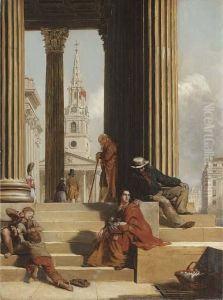Angelo Cohen Hayter Paintings
Angelo Cohen Hayter was a British artist, born in 1829 and passed away in 1917. He was part of the notable Hayter family, which included several artists, most famously Sir George Hayter, who was a court painter and Angelo's father. Angelo's artistic journey was influenced by the rich artistic environment he grew up in, surrounded by the works and the artistic circles of his father. Despite the shadow cast by Sir George's significant achievements, Angelo managed to carve out his own niche in the art world during the Victorian era, a period known for its rapid social, economic, and technological changes, which were often reflected in the art of the time.
Angelo's work encompassed a variety of subjects, including historical scenes, portraits, and landscapes. His style was reflective of the Victorian taste for romanticism and detail, yet he also exhibited a personal touch that distinguished his pieces from those of his contemporaries. Unlike his father, who was deeply embedded in the traditions of court painting and portraiture, Angelo ventured into different territories, exploring the possibilities of watercolor and sketching alongside traditional oil painting. This versatility allowed him to capture the transient beauties of landscapes and scenes from everyday life, as well as more formal subjects.
Throughout his career, Angelo Cohen Hayter exhibited his work at various prestigious venues, including the Royal Academy of Arts, though he never achieved the same level of fame as his father. His contributions to Victorian art, however, remain noteworthy, particularly in how they reflect the era's evolving tastes and the personal explorations of an artist living in the shadow of a prominent figure. Despite the challenges of establishing a distinct voice in such a context, Angelo's works offer a glimpse into the diverse artistic expressions of the 19th century, bridging the gap between traditionalism and the emerging diverse tastes of the Victorian public.
After his death in 1917, Angelo Cohen Hayter's legacy lived on through his contributions to the collections of several British institutions. Though not as widely recognized as some of his contemporaries, his work continues to be of interest to scholars and enthusiasts of Victorian art, especially those intrigued by the dynamics of artistic families and the interplay between personal and historical narratives in art. Angelo's life and work exemplify the journey of an artist striving to find his own path in the shadow of a dominant figure, contributing in his own unique way to the rich tapestry of British art history.
